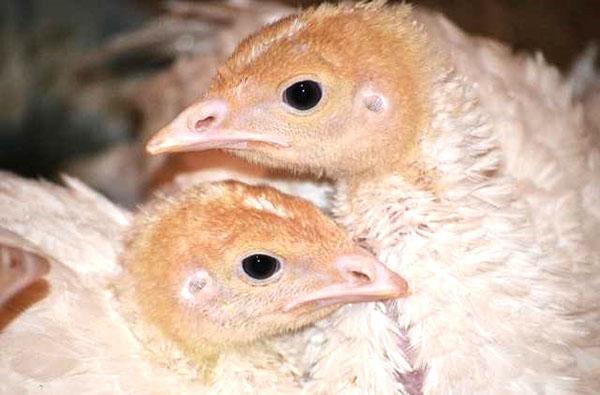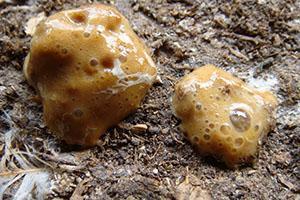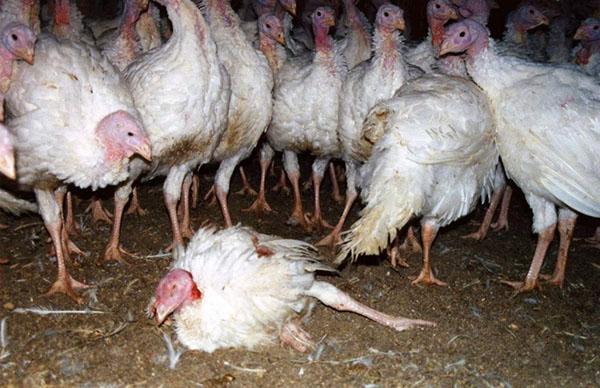Signs of turkey poultry diseases and how to treat them
 Young poultry always require more attention than mature, mature individuals, and turkeys are no exception. It is important for poultry farmers to know the turkey poultry diseases, their signs and treatment, which will quickly and effectively raise the livestock to their feet.
Young poultry always require more attention than mature, mature individuals, and turkeys are no exception. It is important for poultry farmers to know the turkey poultry diseases, their signs and treatment, which will quickly and effectively raise the livestock to their feet.
Preventive measures are even more significant. They will prevent the occurrence of dangerous diseases and, as a result, the weakening and reduction of the growing herd.
Diarrhea in turkey poults: treatment and prevention

The body signals the nestling's malaise: lethargy, refusal to eat, indigestion, which is doubly dangerous due to the washing out of nutrients and mineral salts along with feces. In this case, the causes of diarrhea can be many.
How to find out by external signs why the chick got sick? How to treat diarrhea in turkeys, and how to prevent it in the future?
Diarrhea in young turkeys is most often to blame for poor-quality or not age-matched nutrition, violation of conditions of detention, as well as bacterial and viral infections, sometimes arising as a result of the first two reasons.
If signs of indigestion are detected, experienced poultry farmers are advised to pay attention to the color of the stool.
If turkey poults have brown diarrhea with gruel from poorly digested feed, this signals an imbalance in the feed. Often such a reaction is found on the introduction of a large number of new dressings at once. However, it is possible that food is given in excess, and chicks eat already spoiled mash. In any case, it is necessary to adjust the distribution rate and balance the food composition. As a preventive measure, potassium permanganate is added to the water for turkey poults, and Biovit is added to the feed. In especially severe cases, they resort to the treatment of diarrhea in turkey poults with antibiotics.
Yellow or greenish stools are of a similar nature, while greenishness is a sign of an advanced disease, which is unlikely to get rid of with one exception of a suspicious product.
Litter of a dark, almost black color, combined with the lethargy of the turkey, drowsiness and untidy disheveledness, is a dangerous sign of poisoning. But the most alarming sign for the poultry farmer is white droppings - a symptom of pullorosis and other serious ailments of the bird.
Pullorosis or white diarrhea in turkey poults: treatment and symptoms
 This acute, fatal disease more often affects livestock up to 20 days of age. In addition to sharp-smelling white stools, pullorosis is characterized by a change in the behavior of a previously living mobile turkey. The bird refuses food, suffers from thirst, while almost does not move and, huddled in a corner, sits with closed eyes.
This acute, fatal disease more often affects livestock up to 20 days of age. In addition to sharp-smelling white stools, pullorosis is characterized by a change in the behavior of a previously living mobile turkey. The bird refuses food, suffers from thirst, while almost does not move and, huddled in a corner, sits with closed eyes.
On close inspection, you can see that feathers and fluff near the cloaca with pullorosis look untidy and glued together.
If you do not urgently start treating diarrhea in turkeys, pullorosis leads to seizures, worsening of the condition and death. Even after healing, chicks remain carriers of the disease for a long time.
Coccidiosis in turkey poults: symptoms and treatment
 If in an adult herd this disease can be practically asymptomatic and invisible, then for young turkeys, coccidiosis is a serious threat to life. Infection of chicks occurs when using drinkers, feeders and even bedding alone with a sick bird. In the summer and when turkey poults are fed with warm water, the risk of infection increases sharply.
If in an adult herd this disease can be practically asymptomatic and invisible, then for young turkeys, coccidiosis is a serious threat to life. Infection of chicks occurs when using drinkers, feeders and even bedding alone with a sick bird. In the summer and when turkey poults are fed with warm water, the risk of infection increases sharply.
What are the signs of the disease in turkeys and the treatment of poultry in a backyard environment?
The causative agent of the disease is coccidia, the simplest microorganisms that cause devastating damage to the digestive system of young chicks. The symptoms of coccidiosis in turkeys and the treatment of the disease are determined by the characteristics of the vital activity of this microorganism. Since the pathogen actively multiplies in a beneficial environment, the disease has an extremely dangerous acute nature. Without proper treatment measures, up to half of the turkey poults die in a short time.
About coccidiosis in turkey poults says:
- decreased or loss of appetite;
- lethargy of the bird, inactivity, drowsiness;
- the unreasonable squeak of chicks;
- greedy irrepressible drink;
- untidy appearance;
- diarrhea with traces of blood.
Among the reasons for the spread of the disease can be called crowding in the house, high temperature and humidity, which provoke the rapid reproduction of coccidia and other pathogenic microflora.
 What to do if the turkey poults fall to their feet, vilify, refuse to eat and become weak day by day? First of all, the conditions of detention should be established, the chicks with obvious signs of illness should be deposited and the complex treatment prescribed by the doctor should be started.
What to do if the turkey poults fall to their feet, vilify, refuse to eat and become weak day by day? First of all, the conditions of detention should be established, the chicks with obvious signs of illness should be deposited and the complex treatment prescribed by the doctor should be started.
A similar picture occurs with paratyphoid disease. Among the symptoms of this disease are a wobbly gait, diarrhea, lethargy. That is, the poultry farmer can observe signs similar for many diseases, but the treatment of turkeys is prescribed individually based on the results of a veterinarian's examination.
Diseases such as aspergillosis, candidiasis, infectious sinusitis are dangerous for turkey poults.
Metabolic disorders and vitamin deficiency
At a young age, a deficiency of vitamins and minerals, metabolic disorders due to unbalanced nutrition or the specifics of keeping in a confined space threatens turkeys not only with growth retardation, but also with death.
 When healthy chicks suddenly change their behavior, the poultry farmer has a lot of important and urgent questions:
When healthy chicks suddenly change their behavior, the poultry farmer has a lot of important and urgent questions:
- What to do if the legs of turkey poults are parted, and the bird loses mobility within a few days, stops feeding?
- Why do turkeys peck each other until they bleed?
Although the questions describe different situations, the reasons for the unusual behavior of pets are often the same. In addition to infectious diseases leading to impaired coordination of movements, a lack of calcium and a deficiency of vitamin D leads to falls and refusal to move.
Rickets affects the condition of the joints. This is why turkey poults twist their legs. And wanting to fill the need for microelements, pizzas peck a feather and sometimes behave very aggressively.
 The situation can be changed by actively introducing mineral feed and greens into the diet, while the livestock is being kept in the sun, and also vitamin complexes for poultry are added to the feed.
The situation can be changed by actively introducing mineral feed and greens into the diet, while the livestock is being kept in the sun, and also vitamin complexes for poultry are added to the feed.
Poultry disease prevention
In order to never face the formidable signs of turkey poultry diseases and their treatment, it is important to start prevention from the first day of the chicks' life.
The complex of preventive measures includes protection of chicks by means of vaccination against the most dangerous, often fatal diseases. To maintain immunity, rapid growth and weight gain, vitamin feed, specialized complexes and mineral supplements in the form of chalk and shells are introduced into the diet.
 We must not forget that all feed should be fresh, turkey poults are provided with clean water in abundance, and the feeders and shelves are regularly washed and disinfected. The premises where the bird is kept is also subjected to cleaning.In addition to replacing litter, poultry houses are treated from rodents, helminth eggs and harmful insects. The key to the health of the young will be a place separate from the adult livestock, where the growing turkeys will be spacious, dry and warm.
We must not forget that all feed should be fresh, turkey poults are provided with clean water in abundance, and the feeders and shelves are regularly washed and disinfected. The premises where the bird is kept is also subjected to cleaning.In addition to replacing litter, poultry houses are treated from rodents, helminth eggs and harmful insects. The key to the health of the young will be a place separate from the adult livestock, where the growing turkeys will be spacious, dry and warm.